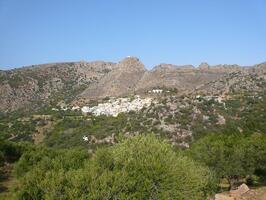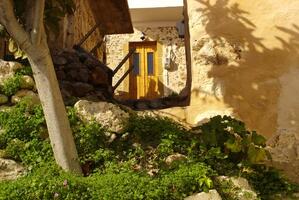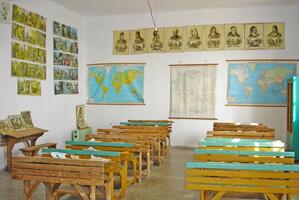Village History
The old years the residents of the village lived from the livestock-farming and least from the agriculture. Cause was the sovereignty of frequent conquerors which keeping in the possession their all productive extents of region up to 1897. For the Christian residents they allowed only the northern mountainous region of the village and a minimal part of the southern flat area for agriculture.
After the revolution in 1897 began the retreat of Turks and the land they had occupied passed to the hands of locals. In 1925 Turks completely abandoned the place and all of their land passed to Christian residents of the village as exchange and trade. In 1936 his dictatorial government of Ioannis Metaxas created the motive: ‘Nor a foot on land to remain unexploited’. The Government then subsidised the planting and culture of olive trees. Since then agriculture was improved in the surrounding area and the south and south-east regions became an enormous olive grove.
A pioneering man called Theofanis E. Kanabakis, planted olive trees in various places and cultivated most of them, mainly in the areas of Kapsalion and Lagada. Nearby a small spring close to the stream known as “Keratia Lagko” he built two water reservoirs and from there it irrigated a big area of his land. Today the spring is dried up due to climate changes and the continuous pumping of an adjacent drill. In 1942 near the reservoirs Mr Th. E. Kanabakis built the first cottage and other locals followed his action with passion and effort proportional to their abilities. The entire region was planted and cultivated at an extent bigger than 3.8 acres from which about 180 tonnes of olive oil are produced today.
Since 1950 the residents of Pefki sometimes on their own and sometimes assisted by the local council and other organisations, however with volunteering and personal work made it possible and improved their living standards. In 1950-51 they built the two big reservoirs of Trypiti and Kara so that the surrounding regions could be cultivated without being weather dependent. In 1952-53 a joint venture with the residents of the nearby village of Agios Stefanos, with their personal work and with minimal assistance from the government made the opening up of the road from Lithines to Pefki and Agios Stefanos.
The first car arrived in these villages on 15 September 1953. In 1953-55 with government owned expense the bridge of the river ‘Peteinos’ was built. Afterwards irrigator work took place and a road network was opened up in rural region. Finally sewerage and all the streets of the village were slabed.
In 1957 the Municipal School above the village was built by personal work of men and women of the village. Prior to this there was a school built in 1911 in front of the church it was inadequate for school. The old school building converted to house and it is still maintained but unoccupied. In the earlier years when there was no school in the village students had to walk to the village Stravodoxari or currently known as Stavrochori, and then to the school of Agios Stefanos.
After 1897 during the years of Cretan State a school was founded in the village. Until then for the school purposes a room of local houses was utilised that students’ parents offered every year free of charge. There were not any desks or chairs and each student has to care of his seat, usually a small stool made from trunk. Books were not available to students. Only the teacher had some books and in a limited number. The students for writing were using a black stone plate, on which they were writing using stone from clay.
The school of Pefki hereafter stands proudly on the top of the slope that the village is and it functions as Folklore Museum of Former Community of Pefki which maintains the Cultural Association of the village.
Today a modern school functions in Makry Gialos, as well as High school and Lyceum.
In 1968-69 became the exterior and internal water supply reservoir of Pefki from the spring “Aspri Vrysi” of Kefala. The years before the sovereignty of Saracens and then in 1471 until the decade of 1890 the water supply and the irrigation of the village was coming from the spring “Vrysi” the currently known as “Kato Vrysi” and its exit there was a water hole. From this water hole locals were taking water with their crocks back to their homes. In the years between 1895-1900 after a proposal made by Mr Aristides Sfakiotakis and volunteering work of the locals, a venetian type water supply system was built, which is known today as ‘Kymeri’ as locals named it.
Later in 1925 the spring was polluted because the wastes from stables and cesspools of the village reached the spring waters. Furthermore the village was extended and the water supply was not enough. From a small spring that was in the place “Kara” locals made a new water reservoir with pipes from clay that the villagers made cooking them in ovens. The new reservoir did not last for a long time because firstly the pipe work was destroyed and secondly the spring dried up. As a result a new water supply system that would be adequate and not dangerous for the public health became crucial. Since then, this water supply system is still in the service of the villagers
In 1970 the village was connected to the electricity network and in 1972 the telephone network was connected. From 1979 up to today the Community has opened up 23 drillings in the search for water supply and irrigation of the village and the settlements. In 1972 the street from the Analypsis to the Aspros Potamos was opened. In 1988 the new oil factory was built. In 1994 the main square of Pefki was widened and a pedestrian zone was opened up in the village.
Historically it is reported that the first radio came in the village in 1936 which at the period of 2nd world war was hidden in houses and caves in order to receive the news from the allied foreheads. Similarly the first television came in the village in 1976. In 1956 and in 1963 was founded and functioned the first surgery. Now the surgery functions in Makry Gialos and serves the residents of Municipality.




